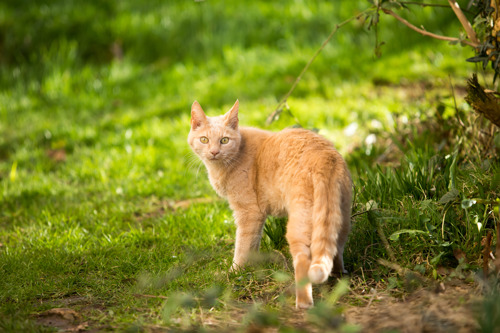There is a growing trend for owners to take their cat for a walk, but is it a good idea? Find out why most cats won’t like being on a harness and lead
Cats love to explore the outdoors and they need plenty of exercise to stay healthy. But letting your beloved kitty wander off outside on their own can be daunting.
If you’re worried about your cat being outdoors, but still want them to enjoy the space, sights and smells of nature, you may have considered taking them for a walk. Just like dog owners do with their pooches.
But cats are very different to dogs and will usually find being walked on a lead very stressful. In fact, there are many reasons why walking your cat is not recommended, which you can read below.

It is much better for your cat if you let them roam free outdoors on their own. There are some precautions you can take to help them do this safely. Find more advice on keeping your cat safe outside.
If you have an indoor cat, providing them with a suitable and exciting home is much more beneficial than taking them for a walk outside. Find more advice about keeping indoor cats happy.
6 reasons why most cats won’t like being walked on a lead and harness
- They don’t like being restrained. If you’ve ever tried to hold your cat while hand-feeding them medication or get them into a cat carrier for a trip to the vet, you are probably aware that most cats don’t like being restrained against their will. Especially for long periods of time. Getting them into a harness is likely to also be very stressful for them.
- They like choice. Cats are very independent creatures. They like to have the choice to go where they want and run away from danger if they feel threatened. Being led on a harness and lead will remove this choice and cause them to feel stressed.
- They are territorial. Cats feel safest in their own familiar territory. Taking them for a walk somewhere they’ve never been before could be frightening for them. Especially if they don’t have the choice to run back to their home if they get scared.
- They could get lost. If your cat gets scared on a walk and you accidentally drop the lead or they escape from their harness, they are likely to run away. If they are in unfamiliar territory, they may run out into a road and risk being hit by a car. Or they may struggle to find their way back home.
- They may meet dogs. While out on a walk your cat may encounter dogs or other animals that they would normally avoid. Some dogs may even try to chase your cat. If your cat is on a lead they won’t be able to run away to safety, making them feel very vulnerable.
- They need privacy to toilet. Unlike dogs, cats need a quiet, private and familiar place to toilet. If they are on a harness and lead they won’t be able to go when they need to.
How to walk your cat safely

Taking your cat for a walk on a harness and lead is not recommended. It is likely to be very stressful and scary for them. If you do decide to take your cat for a walk, there are several precautions you need to take to ensure they are safe and as stress-free as possible. Discover the best way to walk a cat.
- Use a suitable harness. If you take your cat out for a walk on a lead, it’s important that you attach the lead to a cat harness, not a collar. Collars can come off easily, and pulling on a collar with a lead could choke your cat. Use a harness specifically made for cats and make sure it fits them comfortably. To find out how to put on the cat harness, read the harness instructions carefully. Do not leave the harness on your cat when you are not walking them. Remove it as soon as you return home.
- Do some cat harness training. Ideally, you should start cat harness training when your cat is a kitten. This will increase the chance of them being comfortable with it. Start by getting your cat used to being gently restrained while indoors. Reward them with praise or a treat each time to develop a positive association. Gradually increase the amount of time they are restrained, and then move on to using the harness. If at any point your cat appears uncomfortable, go back a step. Always make sure your cat has the option to run away if they want to.
- Get them microchipped. There’s always a chance your cat could escape from their harness or you could drop the lead. Make sure your cat is microchipped and the microchip details are up to date. This will increase the chances of them being returned to you if they do run away and become lost. It’s a good idea to get them neutered and make sure they are up to date with their vaccinations too. Find out more about microchipping, neutering and vaccinations.
- Find a suitable location. The best place to walk your cat is in your own back garden. Then they are close to their home territory and there is less risk of them encountering any dangers. If you do take your cat further afield, avoid busy areas, roads and anywhere there could be dogs.
- Let them lead the way. When walking your cat, keep the lead slack and let your cat choose where they want to go. Avoid pulling on the lead as this will be uncomfortable for your cat.
- Keep walks short. Cats don’t need to be walked for miles. Keep the walks to five to 10 minutes long, at least to begin with. Always pay attention to your cat. If they show any signs of being stressed or uncomfortable, or they want to run away, take them home straight away.
Remember, it is much better for your cat if you let them explore the outdoors on their own, rather than walking them on a harness and lead. If they are an indoor cat, keep them indoors and provide them with a suitable and exciting home.


